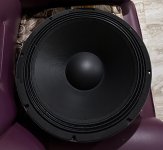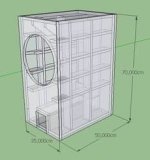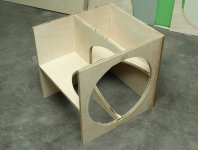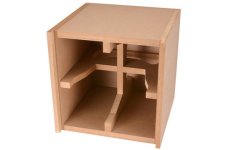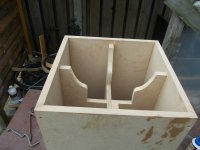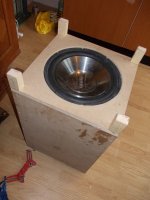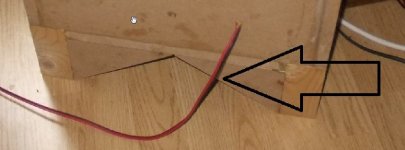Requesting all the experts to advise whether ported or sealed enclosure would be optimal for HT use
1. I have the sub driver (sb audience Bianca 18sw450 (fs 28hz)
https://www.sbaudience.com/index.php/products/subwoofers/bianco-18sw450/
2. I also have minidsp 2x4 HD
3. 6 cu.feet is the enclosure plan I have in mind (for ported)
4. What should be the recommended frequency? My room size is 21x21 and I may plan to add another sub later.
I could not find any previous references for the sub being discussed for HT use, hence this request.
Thank you
1. I have the sub driver (sb audience Bianca 18sw450 (fs 28hz)
https://www.sbaudience.com/index.php/products/subwoofers/bianco-18sw450/
2. I also have minidsp 2x4 HD
3. 6 cu.feet is the enclosure plan I have in mind (for ported)
4. What should be the recommended frequency? My room size is 21x21 and I may plan to add another sub later.
I could not find any previous references for the sub being discussed for HT use, hence this request.
Thank you
Attachments
This is not a question of how much does the woofer need, but more a question of "how much am I able to accept in my room.
Best may be the most simple solution for such a large chassis. Simply build the largest closed box you can and do the rest with amp power and the DSP. Throw in a microphone and you should end up with a perfect sub. If you go for 6 cu. feet or more, you can not do anything wrong with tuning. Just fill the whole thing with RockWool or similar.
The only thing one can not say often enough, brace the cabinet from the inside. Not something like a little cross inside, as you often see it from the lazy guy's, but real bracing of the walls. Do not go for thick walls, as these give wheigt, but no strength. The aim is to make resonating sections so small they resonate out of the sub's frequency response.
PS picture just for an idea of good bracing practice, simple and cheap. Ignore the tunnel vent. You may install a vent (simple round tube) if you think you need some extra dB in your room and must have it. With your room size simply not the case, using an 18" woofer with 11mm linear cone travel.
PPS sound will be perfect for HT and music. If you go vented, it will be more HT, but that is just a general direction, as your room has more influence on the low end than such theoretical ideas. In both cases you should be able to shake the house...
Best may be the most simple solution for such a large chassis. Simply build the largest closed box you can and do the rest with amp power and the DSP. Throw in a microphone and you should end up with a perfect sub. If you go for 6 cu. feet or more, you can not do anything wrong with tuning. Just fill the whole thing with RockWool or similar.
The only thing one can not say often enough, brace the cabinet from the inside. Not something like a little cross inside, as you often see it from the lazy guy's, but real bracing of the walls. Do not go for thick walls, as these give wheigt, but no strength. The aim is to make resonating sections so small they resonate out of the sub's frequency response.
PS picture just for an idea of good bracing practice, simple and cheap. Ignore the tunnel vent. You may install a vent (simple round tube) if you think you need some extra dB in your room and must have it. With your room size simply not the case, using an 18" woofer with 11mm linear cone travel.
PPS sound will be perfect for HT and music. If you go vented, it will be more HT, but that is just a general direction, as your room has more influence on the low end than such theoretical ideas. In both cases you should be able to shake the house...
Attachments
Last edited:
Thanks @Turbowatch2 for the picture. Now I get the idea for bracing and it should be all around to get that strength and stiffness from inside as well. When you said “Do not go for thick walls, as these give wheigt, but no strength” did you mean the thickness of enclosure here or the bracing? After seeing the picture, my instant reaction was to use the same thickness for bracing as the enclosure (3/4 inch). Are you suggesting the thickness should be lesser for bracing?
The other area where I am confused is whether to go for sealed or ported. My intention is to feel that punchiness and not high spl. My current sub is emotiva airmotiv s10 (passive radiator) is good and feel it just does not have that punch at all, hence is the idea for large sub. I can try sealed if it can serve that purpose (with minidsp) and run the sub in bridge mode with crown xls 1502.
If ported, tuning frequency has to be determined and to get all factors align needs some experience or so.
The other area where I am confused is whether to go for sealed or ported. My intention is to feel that punchiness and not high spl. My current sub is emotiva airmotiv s10 (passive radiator) is good and feel it just does not have that punch at all, hence is the idea for large sub. I can try sealed if it can serve that purpose (with minidsp) and run the sub in bridge mode with crown xls 1502.
If ported, tuning frequency has to be determined and to get all factors align needs some experience or so.
'Punch' is in the 100-180 Hz BW, so even if it's in the sub's BW it's still mostly above the box's T/S design (2*Fs/Qts = ~125 Hz), so you want a 'punchy' mid bass, ergo use an HT sub's 80 Hz XO.
21 m or ft? 21 m has a 1st room mode @ ~8 Hz, so sealed for most VLF Vs vented for a 21 ft's ~27 Hz, though IME best to always build vented and plug as desired.
21 m or ft? 21 m has a 1st room mode @ ~8 Hz, so sealed for most VLF Vs vented for a 21 ft's ~27 Hz, though IME best to always build vented and plug as desired.
This is just fine. 3/4" is 19mm which is fine for a large cabinet. In most cases I use the same strength for bracing as for walls.my instant reaction was to use the same thickness for bracing as the enclosure (3/4 inch).
"Most" means that there is nothing religious about such constructions. I combine what ever is the best compromise. For example MDF walls with braces made from plywood. Where I live wood has come rediculously expensive, so I often buy from the "off cut" box in my hardware stores. As you find only smaller panels there, for a fraction of the regular price, I use "expensive" ply inside and cheap MDF outside. I use to recycle wood panels from old furniture etc too.
If you go for a bracing as pictured, make the braces about 3-4 times the panel thickness, like 2 1/2" or 3" for 3/4". You will soon develop a feeling for the right position and space between braces. When you knock on the outside you should get a "dry" feel. Compare that to a bare panel. You are looking for a short, high "tock"... 😉
Inside large cabinets, you may connect opposing walls one or two times. The volume lost by braces can be compensated by filling the free space with RockWool. Cheap and effective it raises the volume seen by the driver 5-10%.
How you do your build depends on your workshop, tools and experience. For a first it may be a good idea to build an open box and add bracing from the inside, after drying. Last to fit is the driver baffle.
Foaming polurethane wood glue is nice, as it fills gaps if your panels are not 100% perfect in size. High strenght construction glue works fine for gaps inside as well.
For that "punch", there are two of them. One you feel instandly on the chest, the 100-180Hz one, usualy together with some smack from the tweeter.
Then there is this other, slower push, which is really forcefull, from the low end. You will get both from this 18" woofer and a closed, DSP corrected cabinet.
A bridged D-amp with clean 1000W + output, like the Crown is a good companion for this sub. You don`t want to hear a stressed amp.
With a large, closed cabinet you can DSP the room in the direction you desire and get what some call a "fast sub". Please accept that a huge portion of the final in room response depends on the room the finished sub is going to play in..
With a vented cabinet you can mess things up quite easy. The cabinet may be a bit on the small side. Some simulation should give you an idea what to expect. There are two data sheets around for your chassis, so better measure it and use your own, real data for the final construction. The gain from a vented sub may even come in an area you don't need it at all. On the other hand you can always close the vent if things go wrong.
Both, vented and closed can give excelent results, there is no right or wrong principle. Vented needs more volume and is more sensible for driver parameter, closed is more flexible for DSP tuning. If you are a beginner go for closed, less room to do things wrong.
Get you self a measuring microphone and a free software, this is the only way to get a perfect end result with such a large beast.
PS you may combine such a brace as picture with stripes, this should give a very stiff box for large volumes.
Attachments
Last edited:
Yeah, it can do both and much more with such a high power handling, wide BW, but assuming an HT receiver/whatever, will still need a powerful mid-bass to fill in whether at 80 or 120 Hz XO and historically using 80 Hz is the better choice overall for positioning, etc., it will still be helping the bottom end through the XO overlap.
@GM @Turbowatch2 - thanks, one last thing before I plan the build activities. Should I be worried about the consequences if the linear xmax stated by manufacturer exceeds when bridging the amp? My principle is to keep the volume of the amp at 60 to 70% and do the volume management in avr and I believe it won’t cause any harm.
This is a nice alternative to a conventional construction.
There only seems to be a mistake in max cone excursion.
There only seems to be a mistake in max cone excursion.
Why is there a mistake at max cone excursion?
Xdamage = 27mm.
Max excursion is 27.09mm @ 35.71hz.
Xdamage = 27mm.
Max excursion is 27.09mm @ 35.71hz.
You picked the wrong number from the posted specs.
You calculated with an Xmax of 27mm , but in reality this this is Xdamage. This is the point where the voice coil hit's the magnet and you have to repair / exchange the driver.
Xmax is only 10.93mm. This is a PA Driver, not some extreme car audio mutation.
So the output of your simulation is not correct as the acoustical power in reality is much, much lower.
You calculated with an Xmax of 27mm , but in reality this this is Xdamage. This is the point where the voice coil hit's the magnet and you have to repair / exchange the driver.
Xmax is only 10.93mm. This is a PA Driver, not some extreme car audio mutation.
So the output of your simulation is not correct as the acoustical power in reality is much, much lower.
Doesn't the bending stiffness of the walls go up as the cube of thickness (t^3), while mass is proportional to thickness? That way the bending stiffness increases at a much faster rate than mass.Do not go for thick walls, as these give weight, but no strength.
Adding internal stiffeners (bracing) certainly helps in that regard. It also does save quite a bit of material (mass).The aim is to make resonating sections so small they resonate out of the sub's frequency response.
Cabinet building for some is a religion, while others consider it a black art. You can complicate it until your brain boils over.
As an alternative you can try to keep it as simple as possible for your situation. Define size, frequency response, material to use, cost's and personal skills. Then you can find a very good compromise. If you want no compromise, use steel reinforced concrete for a sub woofer.
The T-bar is a very simple and effective way to combine strength with low weight. Hard to beat if you stay objective and consider cost's. This is why you find it so often in constructions.
There have been quite some scientifically correct tests of this principle adapted for loudspeaker building.
You can choose plywood, MDF or particle board, with ply giving the lowest weight for comparable strength. T-bar it in a reasonable way and you can consider it perfect. Just because you can CNC does not mean a complicated structure is better than the simple T-bar. I often see such constructions and know this was the marketing, not the research department designing it.
You may use aluminum, elastic layers and artificial stone to build your speakers. In the end you will gain 3% performance and have to pay 1200% more for the materials used.
Sure complicated to define what 3% performance from a cabinet are. In the end, when a wall is dead, does not bend and resonate, this should be 100%. Commercial products are in most cases far away from this "simple" target. For a commercial product low production cost is the target, also it has to match some criteria like weight. You will not buy the low weight sub if the alternative is much heavier...
A huge problem with modern amps, by the way. Spend an afternoon in a HIFI shop and watch how many customers pick up components to get an idea of their mass. Heavy=quality=value. So from similar priced amps the customer will sure choose the objective worse amp if you fix a brick inside.
As an alternative you can try to keep it as simple as possible for your situation. Define size, frequency response, material to use, cost's and personal skills. Then you can find a very good compromise. If you want no compromise, use steel reinforced concrete for a sub woofer.
The T-bar is a very simple and effective way to combine strength with low weight. Hard to beat if you stay objective and consider cost's. This is why you find it so often in constructions.
There have been quite some scientifically correct tests of this principle adapted for loudspeaker building.
You can choose plywood, MDF or particle board, with ply giving the lowest weight for comparable strength. T-bar it in a reasonable way and you can consider it perfect. Just because you can CNC does not mean a complicated structure is better than the simple T-bar. I often see such constructions and know this was the marketing, not the research department designing it.
You may use aluminum, elastic layers and artificial stone to build your speakers. In the end you will gain 3% performance and have to pay 1200% more for the materials used.
Sure complicated to define what 3% performance from a cabinet are. In the end, when a wall is dead, does not bend and resonate, this should be 100%. Commercial products are in most cases far away from this "simple" target. For a commercial product low production cost is the target, also it has to match some criteria like weight. You will not buy the low weight sub if the alternative is much heavier...
A huge problem with modern amps, by the way. Spend an afternoon in a HIFI shop and watch how many customers pick up components to get an idea of their mass. Heavy=quality=value. So from similar priced amps the customer will sure choose the objective worse amp if you fix a brick inside.
I know. I said it was xdamage. So keep it below 27mm. Now if I would have used 10.93mm xmax, then someone would have said "xdamage = 27mm."You picked the wrong number from the posted specs.
You calculated with an Xmax of 27mm , but in reality this this is Xdamage. This is the point where the voice coil hit's the magnet and you have to repair / exchange the driver.
Xmax is only 10.93mm. This is a PA Driver, not some extreme car audio mutation.
So the output of your simulation is not correct as the acoustical power in reality is much, much lower.
I have atleast 3 versions of pdf spec for this driver. The 99db SPL one being the latest from SB audience website. Xdamage increased in this latest spec to 34mm. Others are at 102db and 100db sensitive. Graphs look different. Did SPL get nerfed overtime?
Attachments
@grease61181 - I am not sure but they are certainly shuffling numbers around. The one I bought had 99db sensitivity. Since it is for home use, these updates should not of any concern, hopefully but leaves others baffled. Let’s see how it performs in a box
I had did it this way with mine. now I have change the part around the speaker who points to the floor, set wood like pic 3.This is just fine. 3/4" is 19mm which is fine for a large cabinet. In most cases I use the same strength for bracing as for walls.
"Most" means that there is nothing religious about such constructions. I combine what ever is the best compromise. For example MDF walls with braces made from plywood. Where I live wood has come rediculously expensive, so I often buy from the "off cut" box in my hardware stores. As you find only smaller panels there, for a fraction of the regular price, I use "expensive" ply inside and cheap MDF outside. I use to recycle wood panels from old furniture etc too.
If you go for a bracing as pictured, make the braces about 3-4 times the panel thickness, like 2 1/2" or 3" for 3/4". You will soon develop a feeling for the right position and space between braces. When you knock on the outside you should get a "dry" feel. Compare that to a bare panel. You are looking for a short, high "tock"... 😉
Inside large cabinets, you may connect opposing walls one or two times. The volume lost by braces can be compensated by filling the free space with RockWool. Cheap and effective it raises the volume seen by the driver 5-10%.
How you do your build depends on your workshop, tools and experience. For a first it may be a good idea to build an open box and add bracing from the inside, after drying. Last to fit is the driver baffle.
Foaming polurethane wood glue is nice, as it fills gaps if your panels are not 100% perfect in size. High strenght construction glue works fine for gaps inside as well.
For that "punch", there are two of them. One you feel instandly on the chest, the 100-180Hz one, usualy together with some smack from the tweeter.
Then there is this other, slower push, which is really forcefull, from the low end. You will get both from this 18" woofer and a closed, DSP corrected cabinet.
A bridged D-amp with clean 1000W + output, like the Crown is a good companion for this sub. You don`t want to hear a stressed amp.
With a large, closed cabinet you can DSP the room in the direction you desire and get what some call a "fast sub". Please accept that a huge portion of the final in room response depends on the room the finished sub is going to play in..
With a vented cabinet you can mess things up quite easy. The cabinet may be a bit on the small side. Some simulation should give you an idea what to expect. There are two data sheets around for your chassis, so better measure it and use your own, real data for the final construction. The gain from a vented sub may even come in an area you don't need it at all. On the other hand you can always close the vent if things go wrong.
Both, vented and closed can give excelent results, there is no right or wrong principle. Vented needs more volume and is more sensible for driver parameter, closed is more flexible for DSP tuning. If you are a beginner go for closed, less room to do things wrong.
Get you self a measuring microphone and a free software, this is the only way to get a perfect end result with such a large beast.
PS you may combine such a brace as picture with stripes, this should give a very stiff box for large volumes.
Attachments
Hello everyone - Please I urgently seek your help with the dimensions of the cabinet, especially the port section. I was calculating it in winisd and unexpectedly my laptop power adaptor gave its life up and would not power up anymore. The idea to ignore my laptop's warning about the chargers backfired things at the right time. Now I want to try the vented cabinet for 7.5 or 7 cu.ft tuned to 20 hz (Fs 28 hz) with possibly rectangle ports with flared openings as my carpenter is more confident than using pvc pipes or even front slot port is secondly preferred
could someone with expertise suggest the dimensions?
Thanks in advance
could someone with expertise suggest the dimensions?
Thanks in advance
- Home
- Loudspeakers
- Subwoofers
- Help with decision on SB Audience Bianca 18SW450 sub (home theater)
